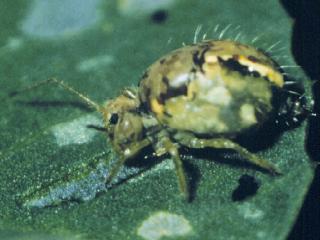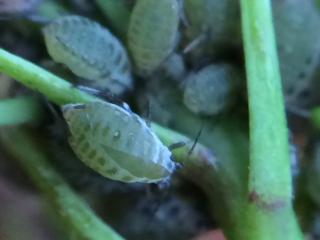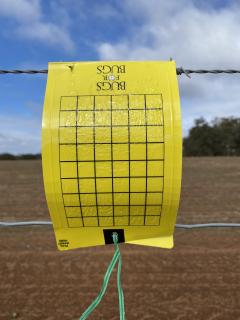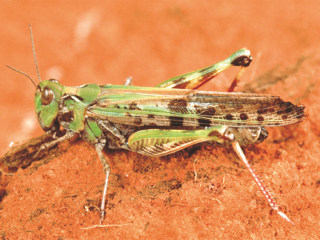Diamondback moth caterpillars are in canola
- Scaddan
- Esperance
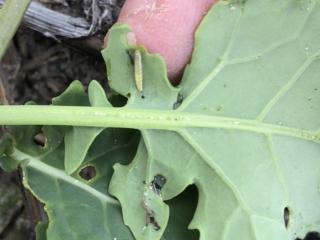
Rachel Minett (Primaries CRT) has reported finding diamondback moth (DBM) caterpillars in a 4 leaf Trident canola crop near Scaddan. One in 30 plants was found to have 1 DBM caterpillar.
Monica Field (Farm and General) has observed canola at the 4-6 leaf stage west of Esperance with chewing damage from DBM. The damage was very patchy, but with the recent warm weather continuing the crop will be monitored for DBM build up.
DBM caterpillars are pale green, cigar-shaped and up to 12mm in length. They wriggle violently when disturbed and can drop down on a fine thread.
Damage from these grubs appears as chewed leaves, buds and flowers with the leaf chewing ranging from irregular holes in leaves to extensive leaf damage.
DBM caterpillar activity should slow down in cold, wet weather conditions and then ramp up in spring.
Growers and consultants are advised to monitor for DBM, especially from August onwards, by doing at least four lots of ten sweeps with an insect net at various locations in each crop.
DBM caterpillars drop from plants when disturbed, and bashing some plants, especially those with holes in leaves, over an ice cream container is a good initial indication of their presence if you don’t have a sweep net handy.
DBM are difficult to control because they breed prolifically and insecticide sprays have limited coverage in advanced canola canopies.
Thresholds for control are:
• pre-flowering (stressed crop) - 30 or more grubs per 10 sweeps
• pre-flowering (no stress) - 50 or more grubs per 10 sweeps.
For more DBM information refer to:
- DPIRD’s 2020 PestFax Pre-season Issue Diamondback moth caterpillars are being found in the ground bridge article
- DPIRD’s Diagnosing diamondback moth page
- GRDC's Diamondback moth fact sheet
- GRDC’s Managing diamondback moth video.
For more information on canola aphids contact Svetlana Micic, Research scientist, Albany on +61 (0)8 9892 8591 or Alan Lord, Technical officer, South Perth on +61 (0)8 9368 3758.
Article author: Cindy Webster (DPIRD Narrogin).
Are you checking canola for false wireworm?
- Gibson
India Warren-Hicks reports finding patches of adult Bronzed field beetle in a canola crop near Gibson. The canola was at the cotyledon stage.
Germinating canola crops are vulnerable to feeding damage from the larvae of bronzed field beetle, also known as false wireworm (FWW), so growers and consultants are urged to check their canola for this insect. Canola germinating in June, in the southern parts of the state are most at risk. Canola sown at this time usually coincides with FWW that are longer than 10mm and this is when most damage occurs.
FWW are dark brown worm-like grubs up to 12mm long and 2-3mm wide with 12 body segments, the last one having two distinct upturned spines.
FWW are native insects that usually eat decaying organic matter but they also chew the stems of young canola plants at ground level, causing ring barking leading to plant death and thinning of the crop.
Control of FWW is difficult because they are usually found under stubble or organic matter which is in the vicinity of canola seedlings. Spraying at the highest registered rate using a synthetic pyrethroid such as alpha-cypermethrin or an organophosphate such as chlorpyrifos has given some control of this pest but the issue is getting the spray to where the pest is. Some growers have reported a better kill by spraying at night when the FWW are most active.
For more information on chemical control refer to DPIRD’s 2020 Autumn winter insecticide spray guide.
For more information refer to DPIRD’s Diagnosing false wireworm and False wireworm – economic considerations for management pages.
For more information on canola aphids contact Svetlana Micic, Research scientist, Albany on +61 (0)8 9892 8591 or Alan Lord, Technical officer, South Perth on +61 (0)8 9368 3758.
Article author: Cindy Webster (DPIRD Narrogin).
Lucerne flea
- New Norcia
- Cadoux
- Tammin
- Cunderdin
An Agworld user has reported finding lucerne flea in a 4 leaf canola crop near New Norcia.
David Stead (Anasazi Agronomy) reports that lucerne flea are being found throughout Cadoux and north of Tammin and Cunderdin largely in lupins and some early cereal crops.
With many crops still germinating or very young, growers are reminded to inspect crops for lucerne flea.
The lucerne flea is a Collembolan or 'springtail'. Adult lucerne flea are approximately 3mm in size and green-yellow in colour.
Lucerne flea attack a range of crops and pastures, causing characteristic ‘windowing’ of leaves. They work up the plants from ground level, eating tissue from the underside of the foliage.
Loamy and clay soils are known to support higher populations of lucerne flea than soils with low clay/silt content because the fine clay is required for reproduction.
Lucerne flea have a high natural tolerance to synthetic pyrethroids so avoid insecticides from this group when selecting chemicals to control Lucerne flea numbers. For insecticide information refer to DPIRD’s 2020 Autumn/Winter Insecticide Guide.
For more information about diagnosing and managing lucerne flea, refer to DPIRD's Diagnosing lucerne flea page.
For more information on canola aphids contact Svetlana Micic, Research scientist, Albany on +61 (0)8 9892 8591 or Alan Lord, Technical officer, South Perth on +61 (0)8 9368 3758.
Article author: Cindy Webster (DPIRD Narrogin).
Aphid activity update
- Geraldton
- Northam
- Albany
- Beaumont
- Esperance
Monica Field (Farm and General) reports that a canola crop east of Beaumont at the 2-4 leaf stage had up to 20 turnip aphids per seedling. Seedlings with this density were found in patches but the turnip aphids were present throughout the paddock.
Plant virologist Dr Benjamin Congdon (DPIRD) reports that surveillance sticky traps in the Esperance zone, that were set up from late April to late May, have caught very low numbers of green peach aphid (GPA) and turnip aphids in this zone. No Turnip yellows virus (TuYV) infection was detected on these aphids.
Almost no aphids have been found in surveillance sticky traps at Geraldton, Northam and Albany that were set up in late May.
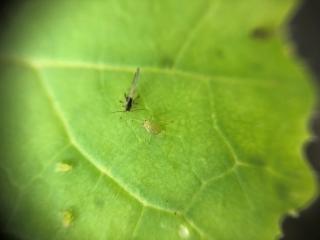
Warmer weather after rainfall may promote dispersal of GPA. Late germination for many crops means crops are still at risk for GPA colonisation and TuYV infection. DPIRD’s surveillance will continue throughout the critical growth period. For more information on TuYV refer to DPIRD’s Managing turnips yellows virus in canola page.
Growers and consultants are reminded to identify any canola aphids found in the crop early. The PestFax Reporter app can be used to help with diagnosing aphids.
For insecticide information on managing aphids refer to DPIRD’s 2019 Winter Spring Insecticide Guide.
For more information on identifying and managing canola aphids see DPIRD’s;
- 2020 PestFax Issue 4 article Aphids are active
- Aphid management in canola crops page
- Diagnosing canola aphids page
- 2017 Protecting WA Crops Issue 3 newsletter Aphids – WA’s insect problem children
- Aphids in your crops YouTube video.
For more information on TuYV contact Dr Benjamin Congdon, Research scientist, South Perth on +61 (0)8 9368 3499.
For more information on canola aphids contact Svetlana Micic, Research scientist, Albany on +61 (0)8 9892 8591 or Alan Lord, Technical officer, South Perth on +61 (0)8 9368 3758.
Article author: Cindy Webster (DPIRD Narrogin).
Article input: Dr Benjamin Congdon (DPIRD South Perth).
Mites are active
Brown wheat mites
- Yuna
Bill Campbell (Bill Campbell Consulting) reports that brown wheat mites have been found in high numbers in a lupin crop near Yuna. Bill said they are concentrated on smaller and stressed lupin plants (growth stage Z1.2-1.4) that are possibly showing herbicide effect, but are not present on larger stronger plants close by. Bill noted that they appeared in the district a fortnight earlier on another lupin crop that was just emerging but the mites had disappeared when the crop was re-inspected a few days later.
Brown wheat mite adults are 0.6mm long, red-brown in colour and globular in shape.
Brown wheat mites tend to be found in pulse and cereal volunteers when the weather is warm prior to the season and often disappear due to cooler wet conditions, before crops emerge. However, in some years they persist and transfer onto germinating crops, especially wheat, and can cause leaf tissue surface feeding damage.
It is possible that the brown wheat mites have persisted because of the relatively warm daytime temperatures in the north and central agricultural regions.
For more information see DPIRD’s Diagnosing brown wheat mite page.
Bryobia mites
- Williams
Brett Jenkinson (Elders) has reported Bryobia mite damage in a 10 hectare patch of moisture stressed canola north of Williams. The canola was at seedling to 4 leaf stage.
Adult bryobia mites are reddish-grey with a pie-shaped body, red legs and two long forelegs. For more information refer to DPIRD’s Diagnosing bryobia mite page.
Redlegged earth mites
- Tammin
- Porongurup
- Mount Barker
- Condingup
David Stead (Anasazi Agronomy) reports that Redlegged earth mites (RLEM) in just germinating wheat (that was previously pasture) north of Tammin.
Agworld users have recently reported finding RLEM in ryegrass near Porongurup, canola at Mount Barker and canola at Condingup.
Redlegged earth mite (RLEM) adults are 1mm long with a black body and eight red-orange legs.
RLEM numbers are expected to increase in areas that experience cold and wet conditions.
For information on applying integrated pest management strategies when managing RLEM refer to GRDC’s Call for best practice approach to control mites media release and Resistance management strategy for the redlegged earth mite in Australian grains and pastures fact sheet.
It is easy to confuse mites so growers and consultants are urged to correctly confirm the identity of mites before making management decisions. Identifications can be made by using the DPIRD MyPestGuide Crops app which includes images and information of mite pests. Alternatively, you can send images for confirmation through the PestFax Reporter app.
For registered insecticide recommendations for mites refer to DPIRD’s 2020 Autumn/Winter Insecticide Guide.
To read about previous mite activity this season refer to the 2020 PestFax Issue 3 article It is important to correctly identify mites as they can be mitey confusing.
For more mite information contact contact Svetlana Micic, Research scientist, Albany on +61 (0)8 9892 8591 or Alan Lord, Technical officer, South Perth on +61 (0)8 9368 3758.
Article authors: Cindy Webster (DPIRD Narrogin) and Dusty Severtson (DPIRD Northam).
Monitor emerging crops for locusts and prepare for hatchings in Spring
- Allanooka
- Walkaway
- Esperance
- Albany
At the end of May Biosecurity officer Mike Jones (DPIRD) reported finding winged adult Australian plague locust (APL) in the Allanooka and Walkaway area. There were ~15 adults per square metre in patches, especially where there are grassy pastures.
Entomologist Svetlana Micic (DPIRD) reported low APL numbers across the state at the end of May. DPIRD surveys found isolated paddocks in the Esperance and Albany shire with less than 10 APL per square metre. The numbers did not pose a risk to emerging crops.
When there are higher numbers of APL (more than 10 per square metre) in pastures adjacent to paddocks that have emerging crops they may be at risk from APL damage, especially as there has been warm weather experienced during the start of this growing season.
Few APL are expected to be present now but growers will need to monitor paddocks that had APL activity in April and May for egg hatchings from mid-September. Sparse, open crops allow sunlight to penetrate initiating hatching and increasing the survival of APL nymphs.
How to identify Australian plague locusts
APL are sometimes found with a range of other, similar looking species of non-winged grasshoppers. The Australian wingless grasshopper (Phaulacridium vittatum), is often confused with the Australian plague locust, especially at the immature stage.
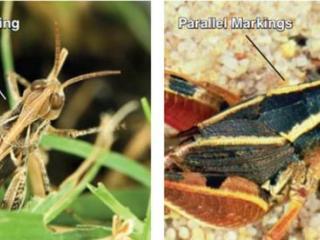
APL always have an x-shaped marking behind the head. In nymphs this can be faded and becomes more visible with maturity, but it is always present.
Adult APL have a dark spot on the otherwise clear hind wing. The dark spot looks like an elongated smudge. They also have red tibia. This distinguishes them from all other species.
For more tips on identifying APL refer to DPIRD’s Australian plague locust: identification field guide page.
Managing Australian plague locusts
There are a number of chemicals registered for locust control including many that are used in canola paddocks for other pests. While synthetic pyrethroids may have been used in a knockdown mix these sprays are not going to have much residual value to protect crops now.
The best strategy is to monitor seeded paddocks for locust numbers and apply a direct application of insecticide if they are damaging emerging crops.
Sprays have better efficacy if applied early in the morning of a day that will be warm. APL adults are more likely to come into direct contact with the spray as they do not move quickly when it is cool. As the day warms up, adults will move onto sprayed vegetation and are more likely to ingest sprayed vegetation. Continue to monitor paddocks as locusts may reinfest a treated area.
For insecticide information visit DPIRD’s Australian plague locust control: registered insecticides page.
Further APL information can be found at DPIRD’s Australian plague locust overview page.
For more information contact Research scientist Svetlana Micic, Albany on +61 (0)8 9892 8591.
Article author: Cindy Webster (DPIRD Narrogin) and Svetlana Micic (DPIRD Albany).




